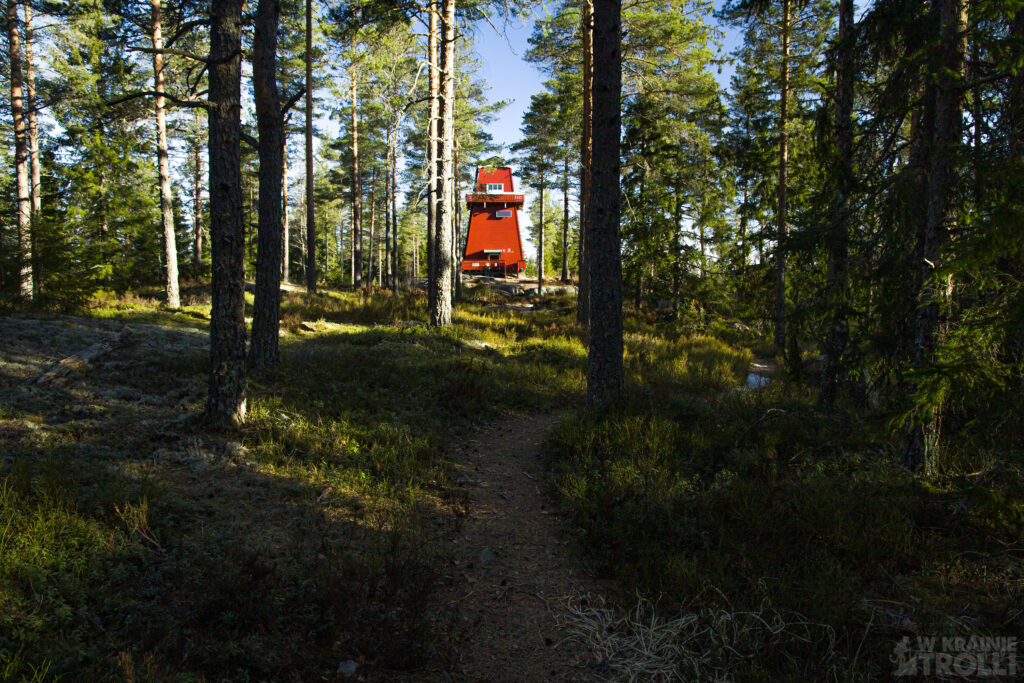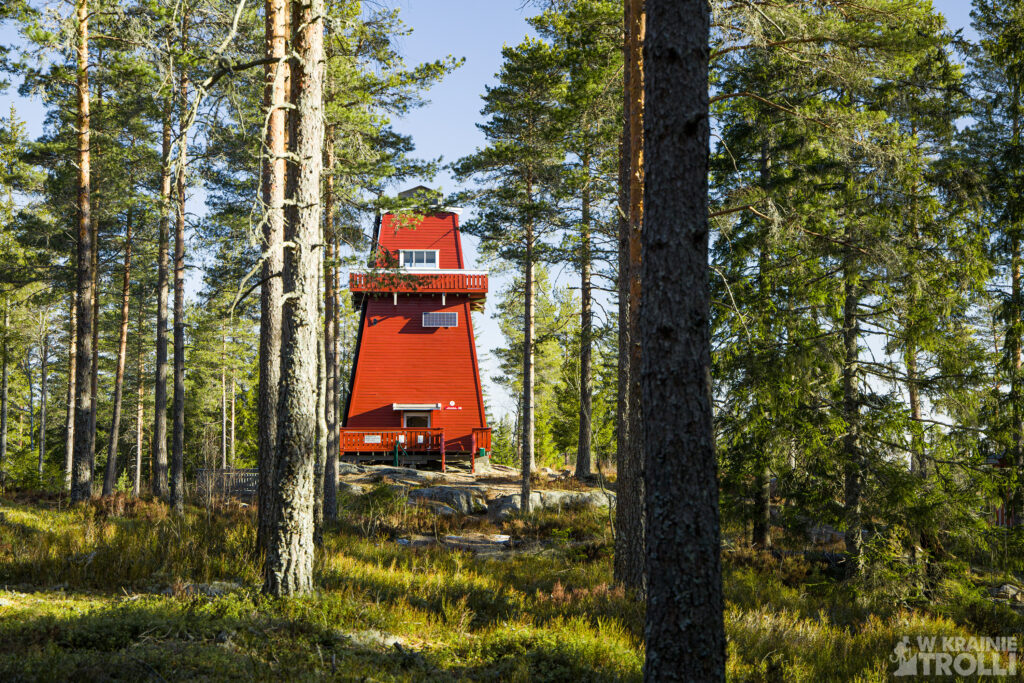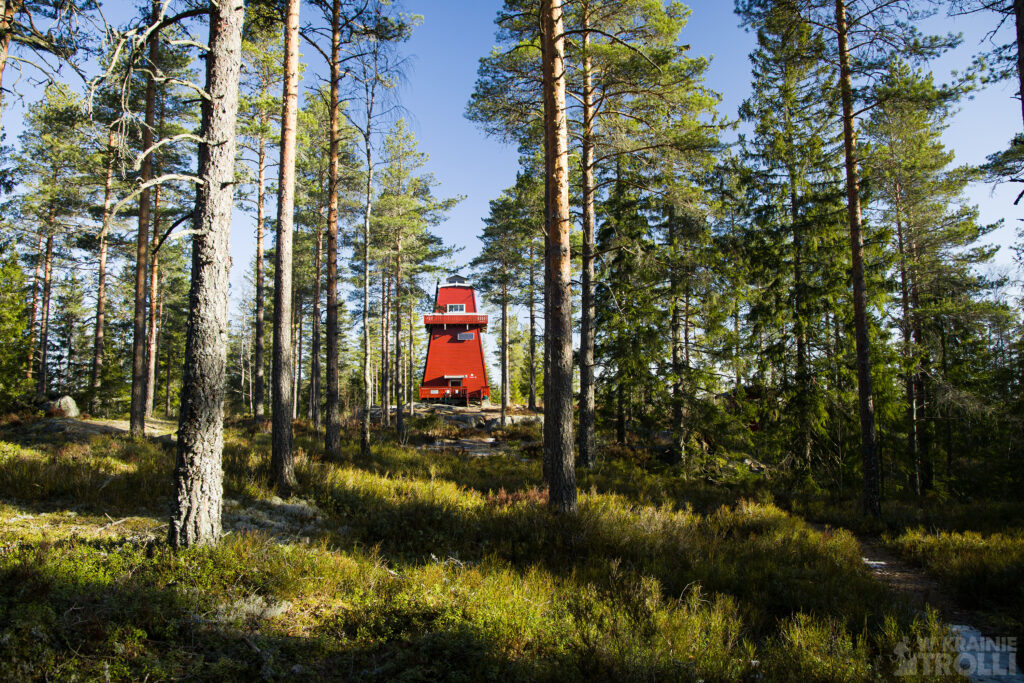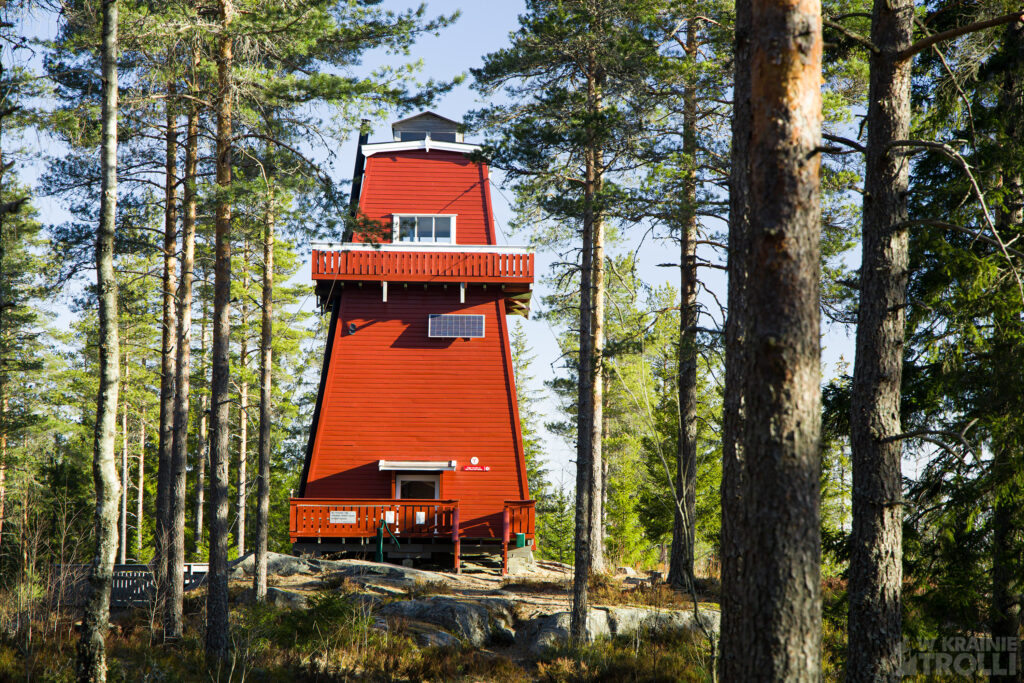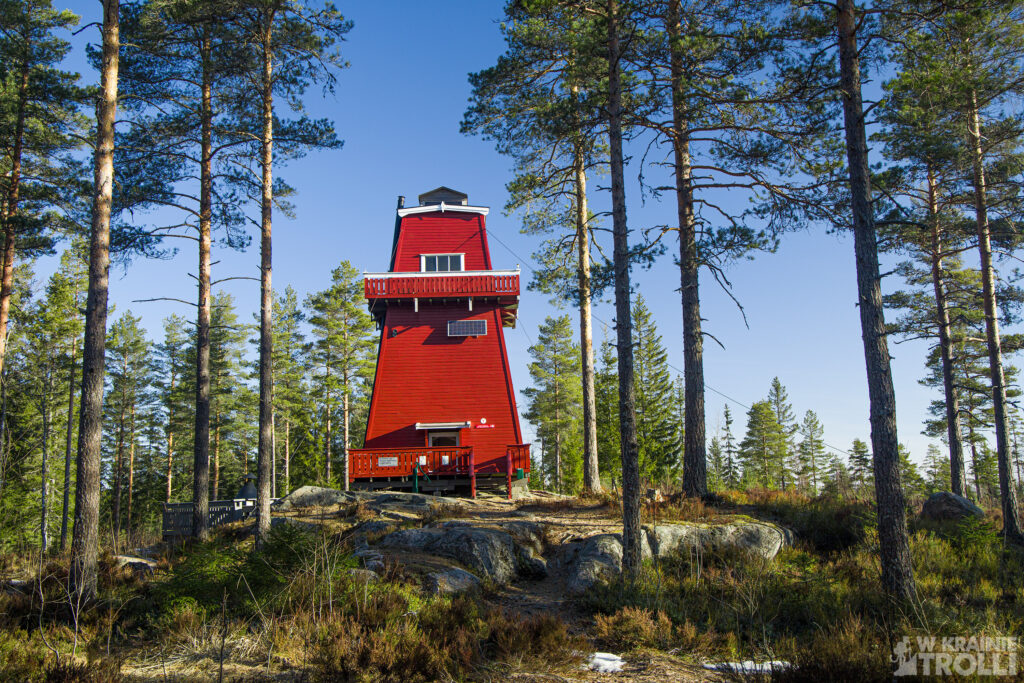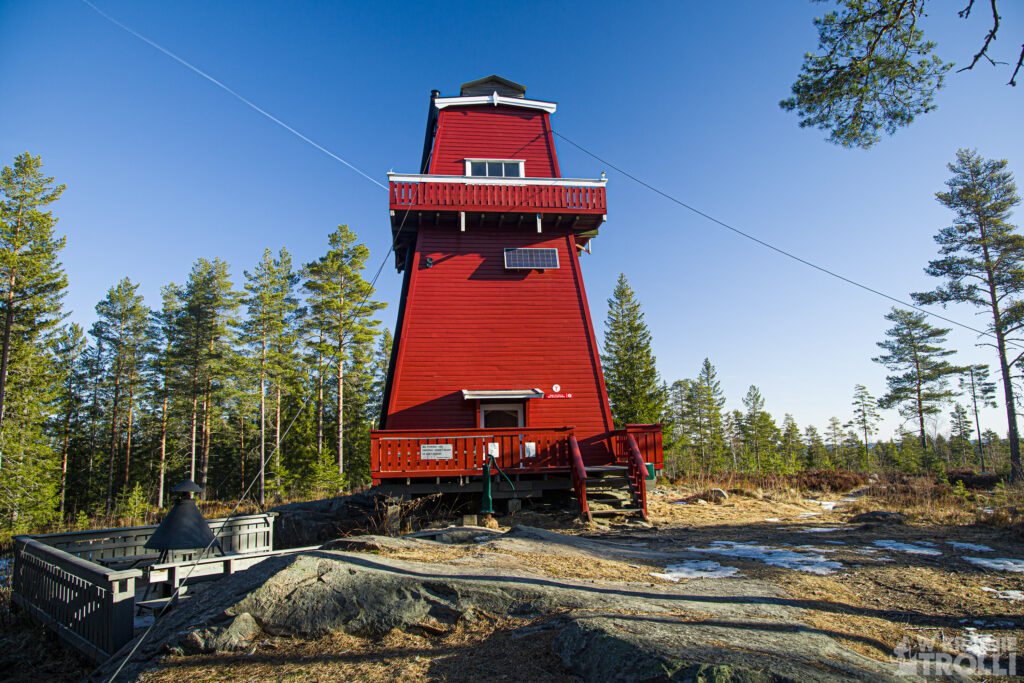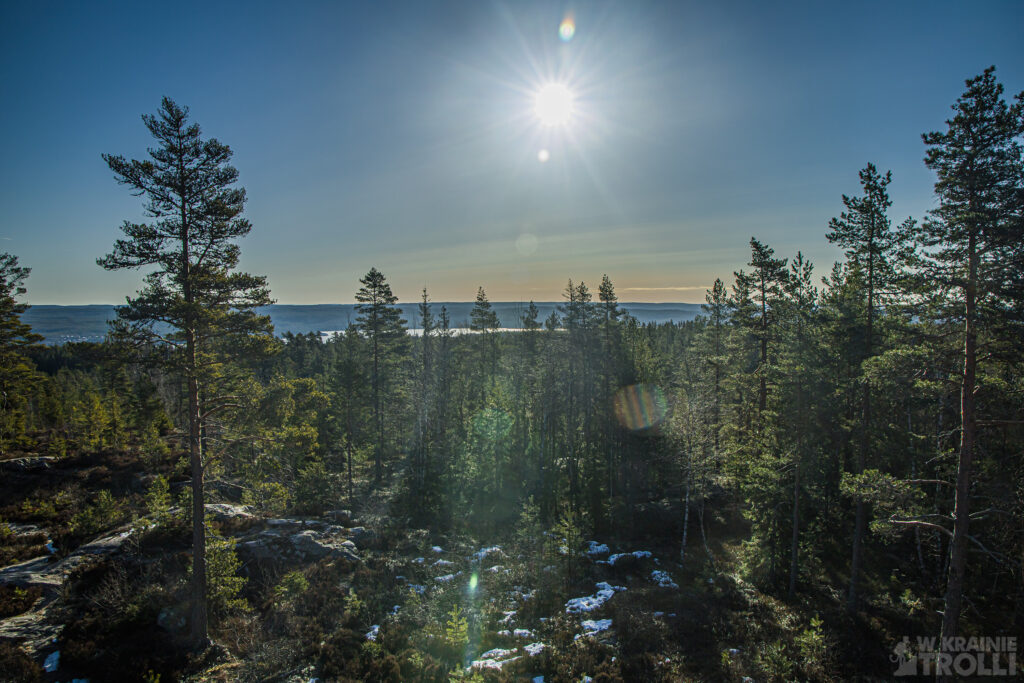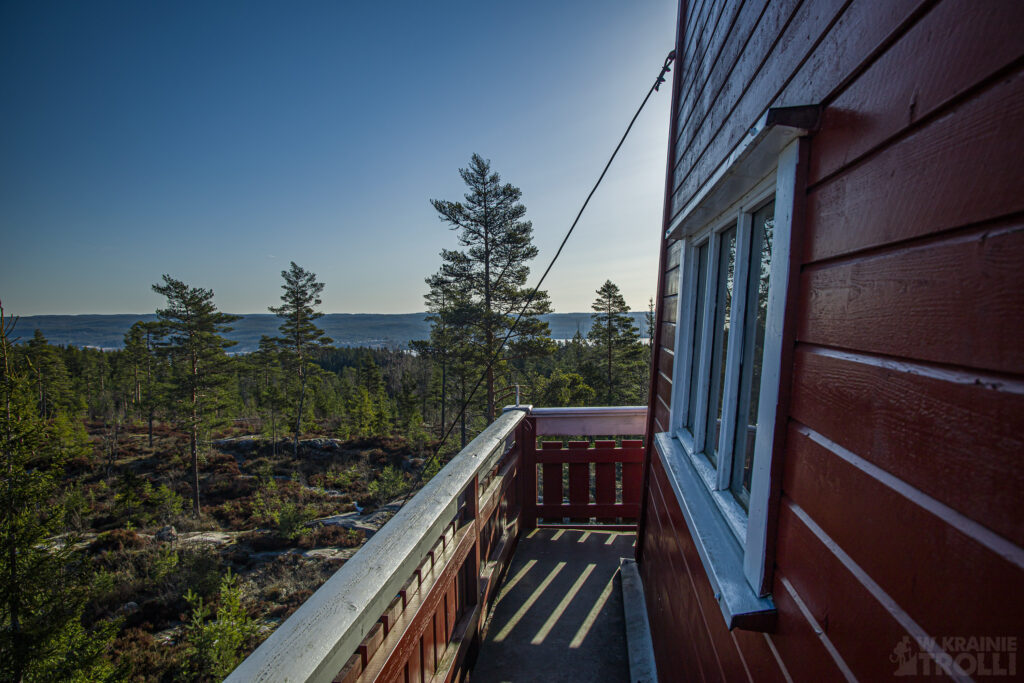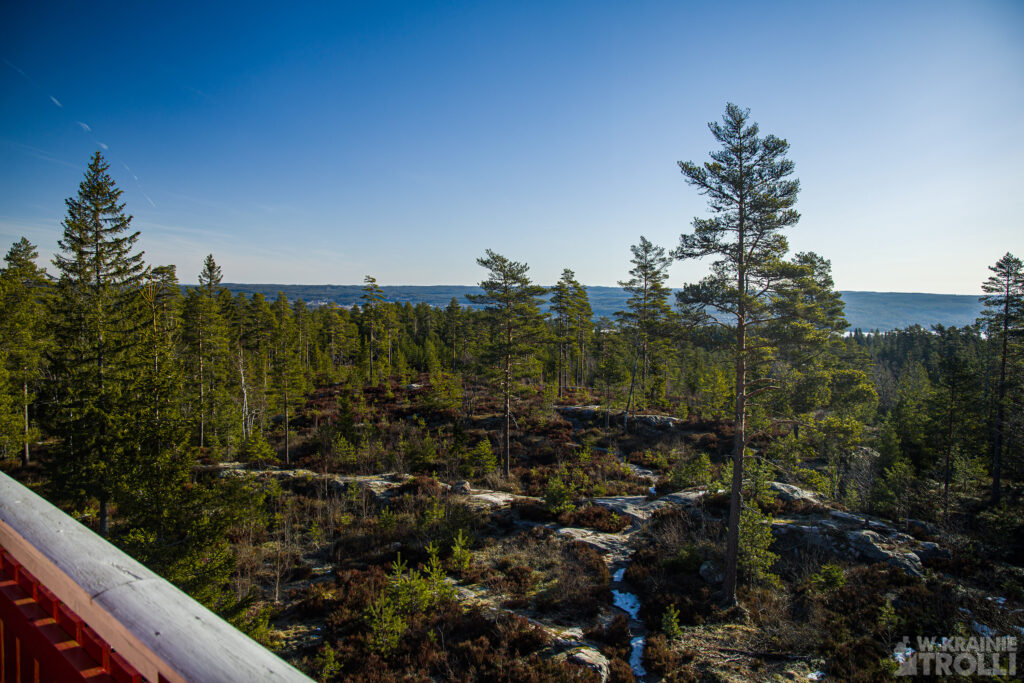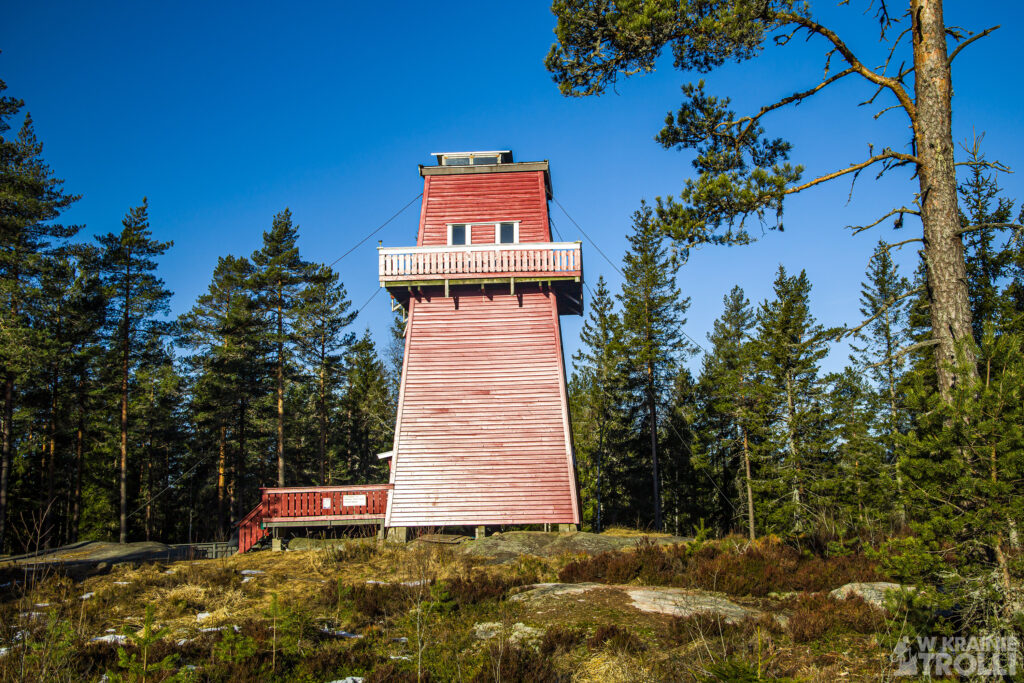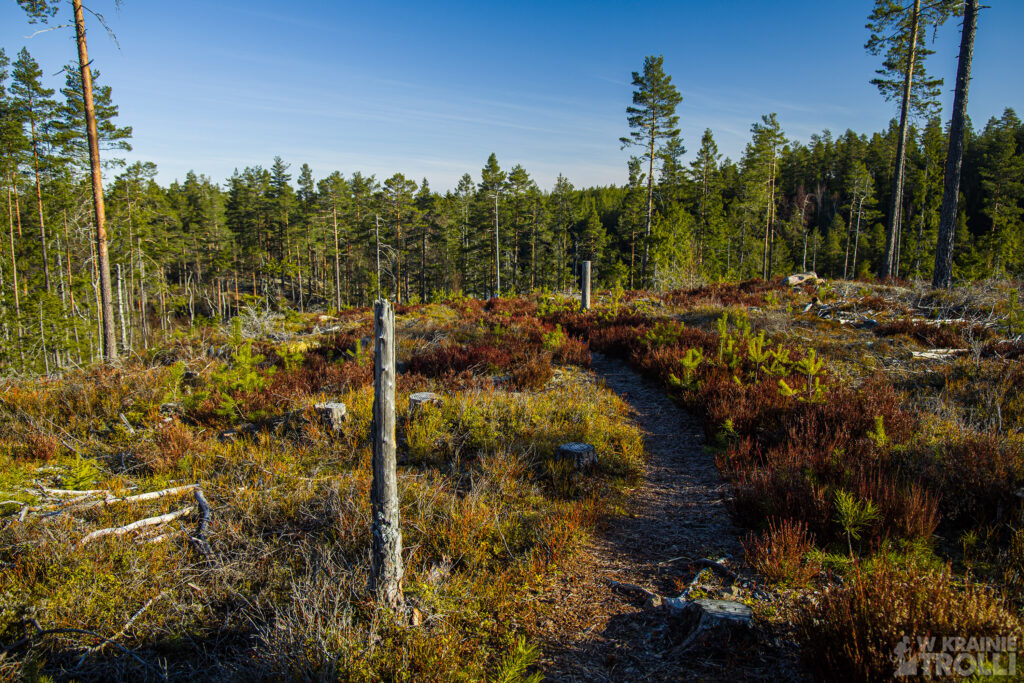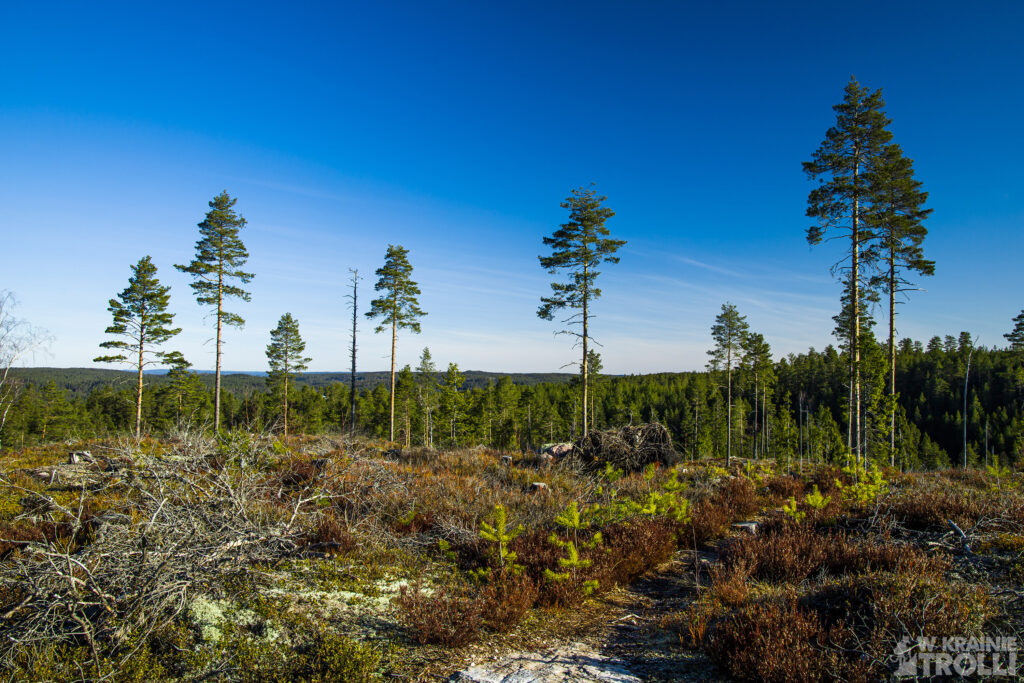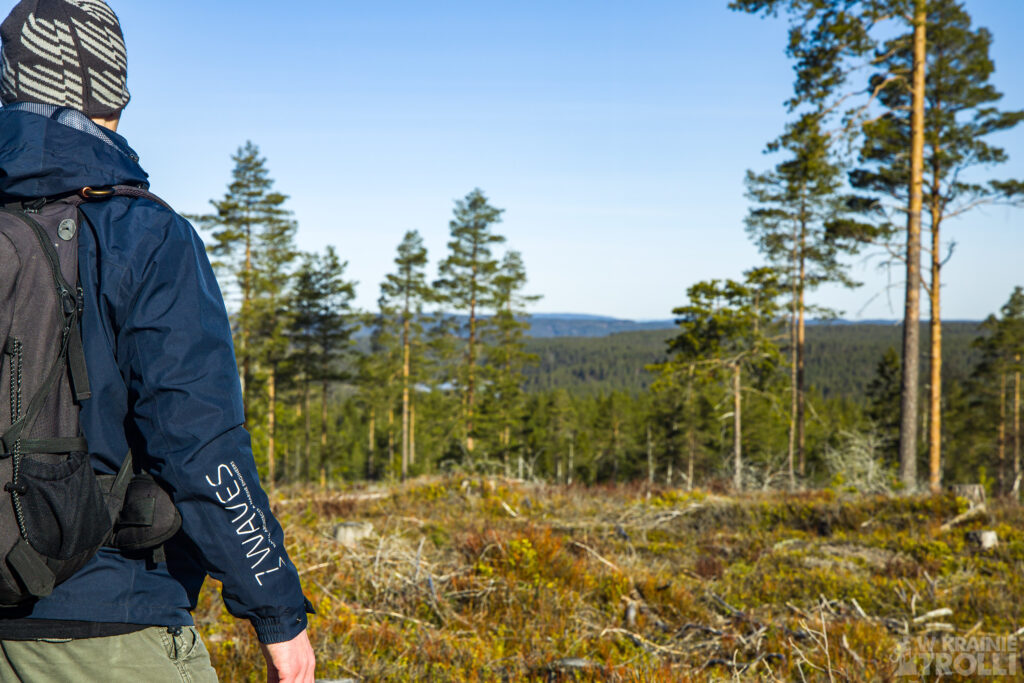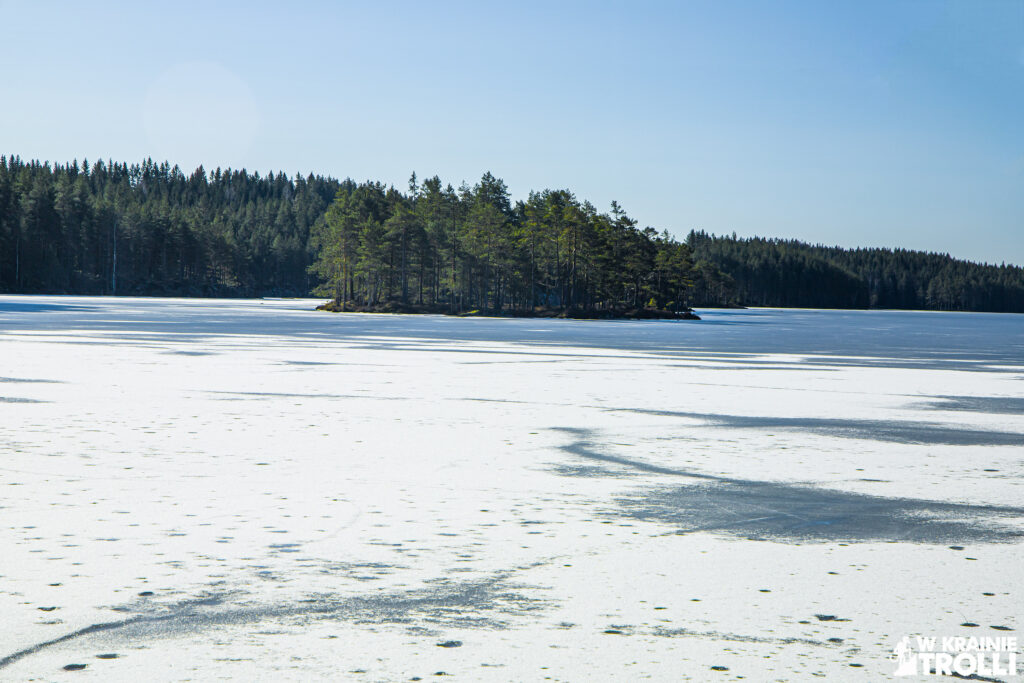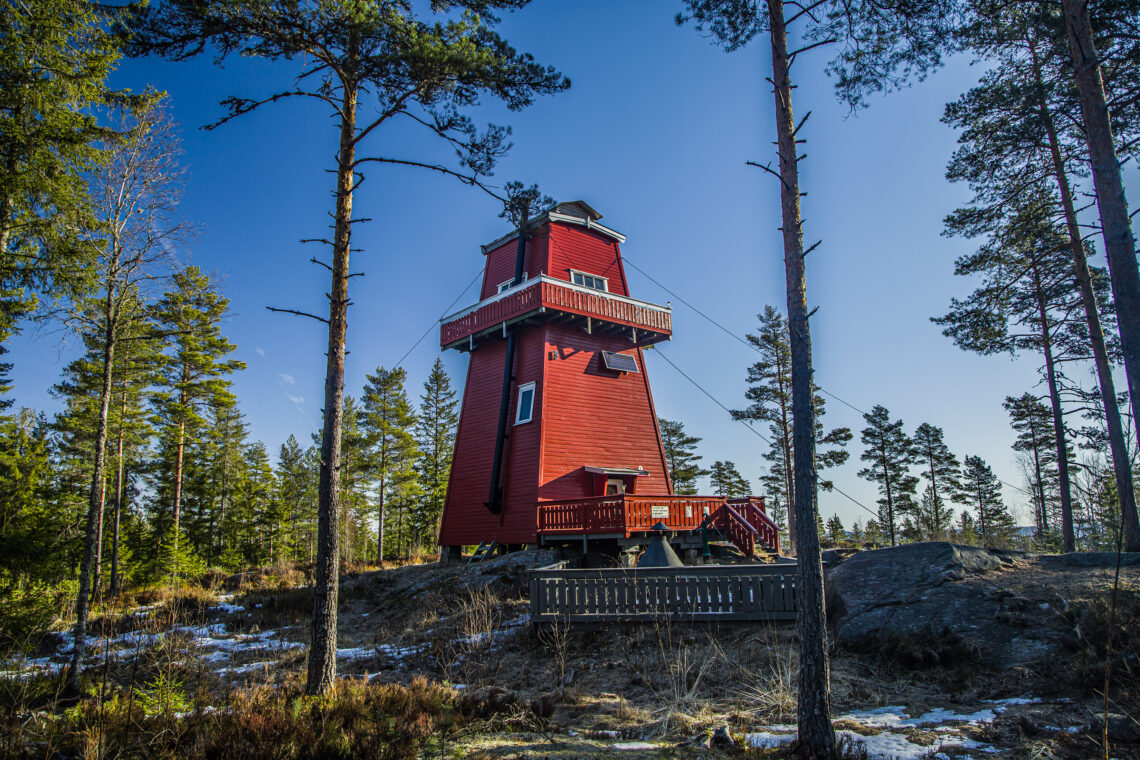
Haukenestårnet
Slavasshøgda to najwyższy szczyt dawnego Østfold. Liczy sobie 336 m n.p.m. i mimo, że sam szczyt porastają gęsto drzewa otaczającego okolicę lasu, i widoku zeń nie ma wręcz żadnego, postanowiłem w końcu na tę górkę wejść. Jednak z uwagi na brak oficjalnej ścieżki (a przynajmniej w internetach takowej nie znalazłem), przesunąłem swój cel wyprawy na odległy o jakieś 4 km dalej na północ obiekt zwany Haukenestårnet.
Jest to wieża widokowo obserwacyjna, umiejscowiona w środku lasu, pełniąca także funkcję schroniska DNT. W środku są zaledwie cztery łóżka, a klucz mogą otrzymać ci, którzy zarezerwowali nocleg na stronie DNT lub wykupili członkostwo organizacji. Wejście na wieżę nie jest zamknięte i po stromych, drewnianych schodach może wejść na górę każdy. Haukenestårnet znajduje się niedaleko osady Haukenes, we wschodniej Norwegii, w rejonie Rømskog, niecałe 10 km od granicy ze Szwecją.
Dojechałem na miejsce wczesnym sobotnim rankiem. Podjechałem autem tak daleko jak tylko mogłem, parkując tuż przy zagradzającym drogę szlabanem. Auto można pozostawić równie dobrze wcześniej, tuż przy głównej drodze 21. Kilkustopniowy mróz zmusił mnie do założenia kurtki, czapki i rękawic. Ruszyłem na szlak. Trasa wiedzie przez las, początkowo szeroką szutrową drogą. Sporadyczne tabliczki z napisem tårnet (wieża) skierowały mnie na wąską ścieżkę i doprowadziły do celu wędrówki.
Wieża prezentowała się naprawdę okazale, zwłaszcza w świetle jasno świecącego porannego słońca. Wszedłem do środka i po wąskich, stromych schodach pokonałem dwie kondygnacje. Na obu piętrach zalegały dziesiątki martwych much. Najwyższe piętko to niewielkie pomieszczenie z niedużymi szklanymi oknami, uniemożliwiającymi zrobienie udanego zdjęcia. Zszedłem wobec tego niżej i bocznymi drzwiami wyszedłem na wąski taras widokowy, ciągnący się wokół wieży. Widoki były naprawdę imponujące, choć w krajobrazie brakowało wznoszących się wysoko gór. Po krótkiej sesji zdjęciowej zszedłem na dół i ruszyłem w dalszą drogę.
Nie wracałem tą samą trasą ale zrobiłem parokilometrowa pętlę. Przez jakiś czas podczas wędrówki towarzyszyły mi dziwne, tajemnicze odgłosy, których źródła nie potrafiłem określić. Dopiero dotarłszy nad brzeg jeziora Ertevann, skąd dochodziły te tajemnicze dźwięki odkryłem ich pochodzenie. Były to odgłosy wydawane przez lód pokrywający jezioro. Tarcie i trzeszczenie warstw zamarzniętej wody jest nie tyle niepokojące ile intrygujące, niczym swoisty syreni śpiew. Miałem wrażenie, że do moich uszu dochodzą zawodzenia uwięzionej pod lodem istoty. Próby uwolnienia jej spełzły na niczym jako, że nie znalazłem wystarczająco dużego kamienia, mogącego przebić grubą pokrywę lodu. Cokolwiek to było, musiało poczekać na odwilż.
W trakcie wędrówki temperatura zauważalnie poszła w górę i drugą połowę trasy mogłem pokonać już bez rękawiczek i w rozpiętej kurtce. Wkrótce dotarłem do samochodu i wróciłem do domu.
Slavasshøgda is the highest peak of the former Østfold. It is a mountain rises 336 m above sea level and even though the summit itself is covered with dense trees of surrounding forest and there is no view from it, I finally decided to hike on this hill. However, due to the lack of an official path (or at least I did not find one on the Internet), I moved my destination to a place called Haukenestårnet, about 4 km further north.
It is an observation tower located in the middle of the forest, which also functions as a DNT cabin. There are only four beds inside, and the key can be obtained by those who have booked a night on the DNT website or have purchased membership of the organization. The entrance to the tower is not closed and anyone can go up the steep wooden stairs.
Haukenestårnet is located near the settlement of Haukenes, in eastern Norway, in the Rømskog region, less than 10 km from the border with Sweden. I got there early on Saturday morning. I drove the car as far as I could, parking right next to the barrier blocking the road. The car can be left as well earlier, just off the main road 21.
The eight-degree frost forced me to put on a jacket, cap and gloves. I went on the trail. The road runs through the forest, initially on a wide gravel road. Occasional signs with the inscription tårnet (tower) directed me to a narrow path and led me to my destination. The tower looked really impressive, especially in the light of the bright morning sun. I went inside and climbed a narrow, steep staircase to climb two levels. There were dozens of dead flies on both floors. The top floor is a small room with small glass windows, making impossible to take a good photo. So I went lower and through the side door I went out to the narrow terrace that stretched around the tower. The views were really impressive, although the high mountains were lacking in the scenery. After a short photo session, I went downstairs and continued my journey. I did not go back the same route, but I did a few kilometers loop. For some time during my journey I was accompanied by strange, mysterious sounds, the source of which I could not recognize. Only after reaching the shores of Lake Ertevann, from where these mysterious sounds were coming, I discovered their origin. They were sounds made by the ice on the lake. The friction and crackling of layers of frozen water is not so much disturbing as intriguing, like a siren song. I had the feeling that the wailing of the creature trapped under the ice was reaching my ears. Attempts to free her failed as I did not find a stone large enough to broke the thick ice cover. Whatever it was, it has to wait until the thaw.
During the hike, the temperature increased noticeably and I was able to make the second half of the route without gloves and in an unzipped jacket. I got to the car and returned home.


